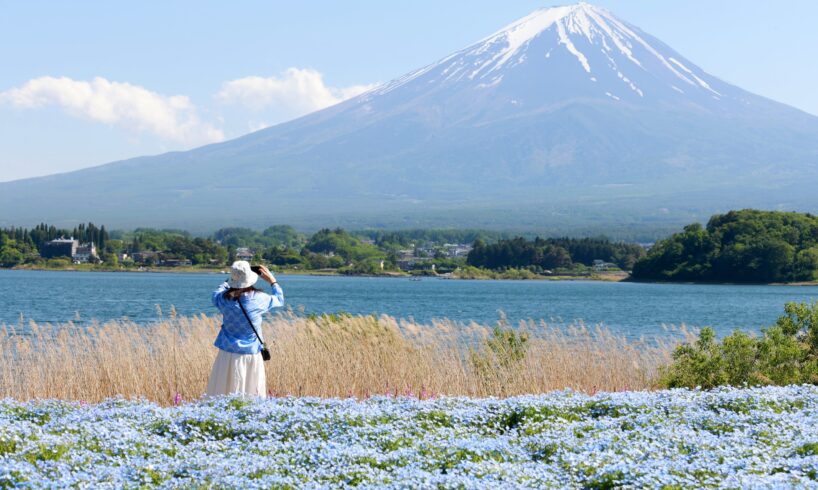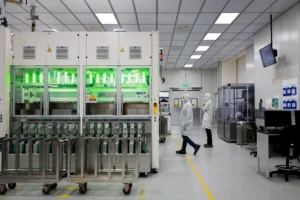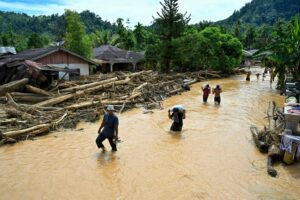
Just two hours from Tokyo by train or bus, Fujikawaguchiko — home to several of the Fuji Five Lakes, including Lake Kawaguchi — is a perfect mix of natural beauty, local flavors and culture. Nestled at the foot of Mount Fuji, it’s compact enough to explore in a day, yet packed with things to see, eat and experience. Whether you’re chasing the perfect Fuji view or a quiet escape from the city, Fujikawaguchiko’s blend of scenic lakeside charm and creative energy makes it a refreshing year-round getaway.
Morning: Panoramic Views
Start your day early with the Mount Fuji Panoramic Ropeway, which climbs to the top of Mount Tenjo in just three minutes. The observation deck at the summit offers a sweeping view of Lake Kawaguchi, the surrounding valleys and, on a clear day, even the Fuji-Q Highland amusement park. This spot also has a whimsical side — the area is inspired by a Japanese folktale about a mischievous rabbit and tanuki (raccoon dog), and you’ll spot playful rabbit motifs scattered throughout the mountaintop park.
Once you’re done taking in the view, consider hopping aboard the Appare, a sightseeing boat modeled after a Sengoku-era warship that cruises the waters of Lake Kawaguchi. The cruise lasts about 20 minutes and offers a completely different perspective of Mount Fuji. If you’re lucky, you might even spot the elusive “Sakasa Fuji,” the perfect reflection of the mountain — upside down — on the lake’s still surface. The northern shore, around Kawaguchiko Ohashi Bridge, is the best area for this phenomenon. Visit early in the morning for calm water and the clearest skies.
Late Morning: Art Meets Nature
Fujikawaguchiko’s creative side shines through its collection of museums and art spaces, each of which boasts a distinct personality.
Begin with the Kawaguchiko Muse Museum, known for its permanent exhibitions of the works of Yuki Atae, a doll artist renowned for crafting lifelike dolls dressed in intricate clothing and posed within elaborate sets. Next, make your way to the Itchiku Kubota Art Museum, dedicated to the textile artist who revived the ancient tsujigahana silk-dyeing technique. His kimono series, inspired by the changing seasons surrounding Mount Fuji, are displayed in an atmospheric, Gaudi-esque building that blends beautifully with nature.
If you’re in the mood for something whimsical, stop by the Kawaguchiko Music Forest Museum, designed to resemble a European alpine village with cobblestone streets and old-style stone buildings. Inside, you’ll find one of Japan’s largest collections of antique self-playing instruments, from music boxes to full-sized dance hall organs.
Lunch: Houtou, Yamanashi’s Comfort Food
By midday, it’s time for something hearty. Fujikawaguchiko is famous for houtou: thick, flat noodles stewed in a miso-based broth with seasonal vegetables. Houtou Fudo is a famous chain with four shops just within the Fujikawaguchiko area. The Higashikoiji branch, instantly recognizable by its futuristic, white dome-shaped building, is the most distinctive. Inside, steaming bowls arrive quickly, making it a perfect lunch stop before the afternoon’s adventures.
For a quieter, less touristy alternative, try Koshu Houtou Kosaku, a local favorite, where the rustic setting matches the homestyle cooking. Portions are generous, and the broth has a depth that warms you right through.
Afternoon: Ropeways, Walks and Hidden Views
In the afternoon, head toward Kawaguchi Asama Shrine, one of the region’s most historically significant spiritual sites. Founded in 865 CE, it was built to honor the mountain goddess Konohanasakuya-hime and to calm Fuji’s volcanic eruptions. The sando approach lined with ancient Japanese cedar trees, some over 1,200 years old, creates a tranquil tunnel of green.
If you’re visiting in autumn, don’t miss the Momiji Kairo, or Maple Corridor, a 150-meter tunnel of red-tinged maple trees. In the evenings, the foliage is brilliantly lit up as part of the Fujikawaguchiko Autumn Leaves Festival, which also features stalls selling local crafts and snacks beneath the illuminated canopy. The festival is generally held from around late October to late November, though dates may change from year to year.
Soak and Unwind: Fujikawaguchiko’s Onsen Culture
No trip to Fujikawaguchiko feels complete without an onsen stop. Public day-use options like Fuji Yurari Hot Spring offer multiple baths with Fuji-facing views, while some hotels allow day-trippers access to their hot spring facilities. The experience of soaking outdoors while gazing at Japan’s most famous mountain is reason enough to linger until evening.
Evening: Dinner and Fuji
From the lakeside promenade near Oishi Park, Mount Fuji glows in the sunset, its reflection rippling across the water as the day quietly gives way to dusk. The park is one of Fujikawaguchiko’s most beloved spots — a long, open stretch of lakefront, where flowers bloom in changing colors throughout the year. In spring, tulips and pink moss phlox carpet the paths; in summer, lavender fills the air with its scent; and in autumn, fiery red kochia shrubs create a dramatic contrast against Fuji’s blue outline. Even in winter, when the fields rest beneath frost, the crisp air and unobstructed view make it one of the best places to photograph the mountain.
Getting to Fujikawaguchiko From Tokyo
By train: JR Chuo Line limited express from Shinjuku Station to Otsuki Station, then Fujikyu Railway to Kawaguchiko Station.
By bus: Direct highway bus from Shinjuku.
The trip takes about two hours, whether traveling by train or bus.
Tip: The weather around Fuji is unpredictable. If clouds hide the peak, you can still focus on cultural stops and hot springs — the mountain often reappears when you least expect it.
Related Posts
Discover Tokyo, Every Week
Get the city’s best stories, under-the-radar spots and exclusive invites delivered straight to your inbox.
Updated On October 17, 2025





